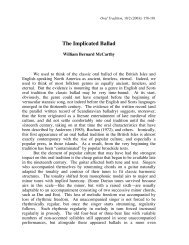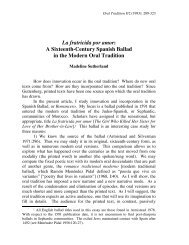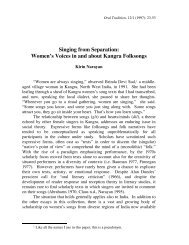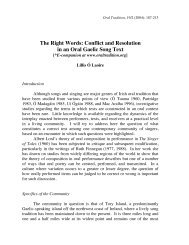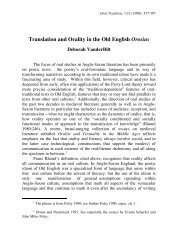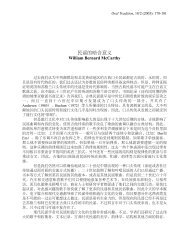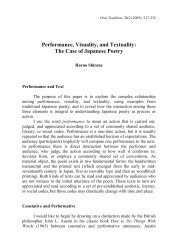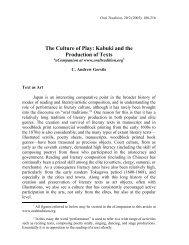Garner and Miller - Oral Tradition Journal
Garner and Miller - Oral Tradition Journal
Garner and Miller - Oral Tradition Journal
Create successful ePaper yourself
Turn your PDF publications into a flip-book with our unique Google optimized e-Paper software.
360 LORI GARNER AND KAYLA MILLER<br />
Crimmins himself began beekeeping when, he explains, “an older beekeeper, he kind of<br />
took me under his wing <strong>and</strong> mentored me.” While Richard Underhill 15 <strong>and</strong> his wife first became<br />
interested after a one-day introductory class, much of his knowledge was acquired person-toperson<br />
from an experienced beekeeper who had been practicing for sixty-four years.<br />
The role of texts in the transmission of this dynamic tradition provides a productive<br />
model for underst<strong>and</strong>ing how the marginalia of CCCC 41 might have functioned in the context<br />
of an ambient oral tradition. When asked about beekeeping books, Crimmins explains that he<br />
does read beekeeping books <strong>and</strong> regularly reads emails from beekeeping groups. Similarly,<br />
Underhill states that “I read quite a bit”; however, he goes on to clarify that texts alone provide<br />
far from sufficient training: “Beekeeping I consider both an art <strong>and</strong> a science. The science you<br />
can get from the literature,” but equally necessary is what Underhill calls “art,” “the craft that’s<br />
passed on from experience” (2010a). Crimmins, too, speaks explicitly of a balance between “art”<br />
<strong>and</strong> “science.” Their elaboration of this relationship reflects what Barre Toelken refers to as the<br />
“twin laws of folklore process,” “conservatism <strong>and</strong> dynamism” (1996:39) or the “variation<br />
within limits” that John Miles Foley attributes to traditional verbal art. 16 For Underhill <strong>and</strong><br />
Crimmins, the “science” consists of more or less static facts where the “art” involves constant<br />
innovation <strong>and</strong> variation to meet situation-specific needs. Speaking of swarms specifically,<br />
Underhill explains that every swarm is different. It “depends on where it’s located, how high it is,<br />
what they’re hanging on,” <strong>and</strong> there are “numerous tricks that people have devised over time,<br />
<strong>and</strong> each occurrence involves you having to devise a plan to how you are going to capture this<br />
[swarm].” While much has of course changed with regard to beekeeping practices, the inherent<br />
variability of swarms is a phenomenon of nature connecting medieval <strong>and</strong> modern beekeepers<br />
<strong>and</strong> necessitating constant innovation within traditional practices during both time periods.<br />
Beekeepers’ use of the Internet when h<strong>and</strong>ling this infinite variety of swarms is in some<br />
ways parallel to the role of oral-derived texts in Anglo Saxon times. Much more so than books,<br />
the Internet today provides a dynamic forum for exchange, through emails from beekeeping<br />
groups <strong>and</strong> electronic newsletters, as Crimmins explains. <strong>Oral</strong> tradition <strong>and</strong> Internet technology,<br />
as Foley argues, are “surprisingly similar in their structure <strong>and</strong> dynamics,” both media depending<br />
“not on static products but on continuous processes” (2011-:“Getting Started: How to Surf The<br />
Pathways Project”). Both media “invite <strong>and</strong> require active participation <strong>and</strong> support a rich<br />
diversity of individual, one-time-only experiences” (ibid.). It is thus quite natural that beekeepers<br />
already embracing oral traditional modes of communication would gravitate toward online media<br />
for transmission of shared <strong>and</strong> knowledge <strong>and</strong> experience. This connection between Internet<br />
technology <strong>and</strong> oral tradition offers a productive way to recontextualize the poetry in Wið Ymbe,<br />
as a starting point for necessary innovation rather than a fixed <strong>and</strong> final solution in itself.<br />
Like Anglo-Saxon beekeeping, at least as attested in the margins of CCCC 41, modern<br />
American beekeeping has at times also relied on the mnemonics of poetry in its transmission of<br />
practical knowledge. Comparison of Wið Ymbe’s incantation with a modern Internet parallel can<br />
15<br />
Except where otherwise noted, quotations from Richard Underhill refer to a personal interview<br />
conducted by Kayla <strong>Miller</strong> on July 14, 2010, at Peace Bee Farm in Proctor, Arkansas.<br />
<br />
16<br />
<strong>Oral</strong> tradition “thrives on its ability to vary within limits. Every context is unprecedented as well as<br />
generic; each poet <strong>and</strong> poem <strong>and</strong> performance is in some fashion unique” (Foley 2002:140).



